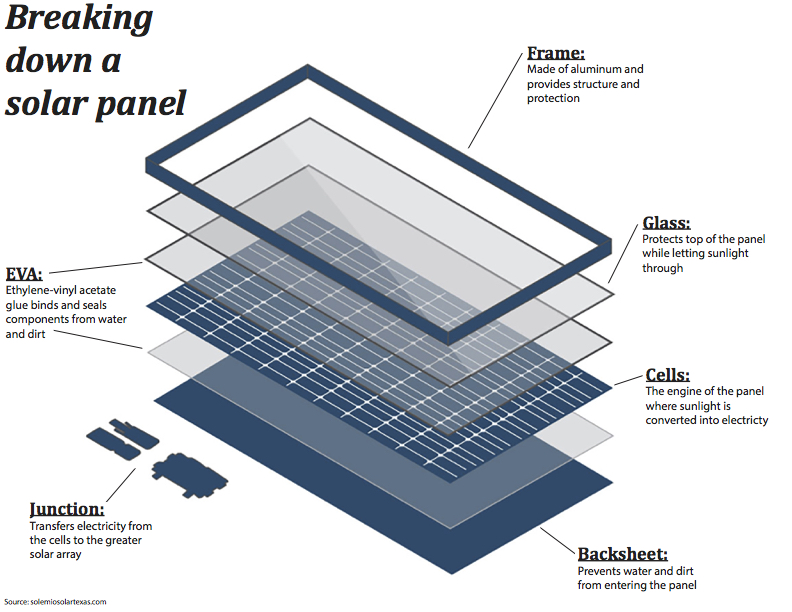Editor’s Note: This is the fourth in a series of articles examining the impact of a solar farm planned for installation in Sulphur Springs.
For this article, we thought we’d “illuminate” some facts about the Solemio solar farm and how those shiny solar panels work.
A SHORT SCIENCE REVIEW
Sunlight consists of particles called photons, which are beamed across the 93 million-mile-wide vacuum of empty space and reach the earth approximately eight minutes and 20 seconds later (hence, the speed of light). Atoms are the building blocks of all matter and are made up of varying numbers of protons (positive charge, but not an electrical charge), electrons (negative charge) and neutrons (neutral – no charge).
There are two different main types of solar installations – rooftop and utility. Both types use photovoltaic (PV) panels, which are, essentially, a sandwich. There is a “slice” of impact-resistant anti-reflective glass on the top and an electrically neutral backsheet on the bottom.
Next, there are two layers of ethylene-vinyl adhesive to hold and seal everything together.
The “meaty” center of this sandwich is a solar cell, which is an electrical device that contains a semiconductor material like crystallized silicon. Second generation solar cells use amorphous silicone, cadmium telluride (CdTe) or copper- indium-gallium-selenide.
As these atoms hit the silicon atoms of the solar cell, they transfer their energy to loose electrons, knocking them off the atoms. This releases energy, which is captured and carried to a converter, where it is turned into electricity.
Rooftop installations are PV panels mounted to the roof of a house or building. A rooftop solar installation generally supplies electricity to only the structure on which it is mounted.
A utility-scale solar installation works pretty much the same way, just on a much larger scale.
Everything is bigger – the number of panels, the size of the panels themselves and the amount of electricity generated.
Sunlight is collected in one of two ways – using either thousands of larger PV panels or a concentrated solar power (CSP) system. Photovoltaic panels are by far the most common method used worldwide.
The panels are linked together to form arrays, and solar inverters convert the array’s power output from direct current to alternating current. The inverters are connected to the power grid through a high voltage transformer.
A CSP system uses mirrors or lenses to concentrate a large area of sunlight onto a small area. Electricity is generated when the concentrated light is converted to heat (solar thermal energy), which drives a heat engine (usually a steam turbine) connected to an electrical power generator.

MYTH-CONCEPTIONS
It’s a myth that solar panels don’t work on cloudy days. The panels work more effectively on sunny days, but they can still generate electricity even if it’s cloudy or raining. Rain actually helps to keep the panels clean, allowing them to collect more energy.
Another myth is that utility-scale solar farms create glare. Concentrating solar power systems do use mirrors that can cause glare, but most solar farms use PV modules to generate electricity. PV modules use non-reflective glass and are designed to absorb rather than reflect the light that hits the panels in order to convert solar energy into electricity. PV modules are generally less reflective than windows and are installed at numerous airports.
Another concern about utility-scale solar facilities is noise. The noisiest components in a solar farm are the inverters, which generate a low buzzing sound as they convert electricity from the direct current generated by PV modules to alternating current used by the electric grid.
Tracking equipment allowing PV modules to face the sun over the course of the day can also generate a low level of noise.
However, the noise generated by solar farms is generally not audible above ambient noise outside of the facility fence.
SOLEMIO UPDATE
The Solemio project website (www.solemiosolartexas.com) states construction is scheduled to begin in Summer 2019, with operations slated to begin in Summer 2020.
Contractors have already started doing some preliminary work at the site, but major construction has yet to begin.
According to Shari Mohl, one of the neighbors to the site, the original developers are still working out some issues before they can complete the sale of the project to Pattern Energy. Mohl currently leases some acreage which is included in the solar site’s boundaries. Originally, her lease was to expire at the end of June, but she said she was recently told by the landowner that the cattle she has on the property can stay until the end of August.
UP NEXT
The fifth article in the series will discuss agricultural and environmental impacts of utility-scale solar installations.


